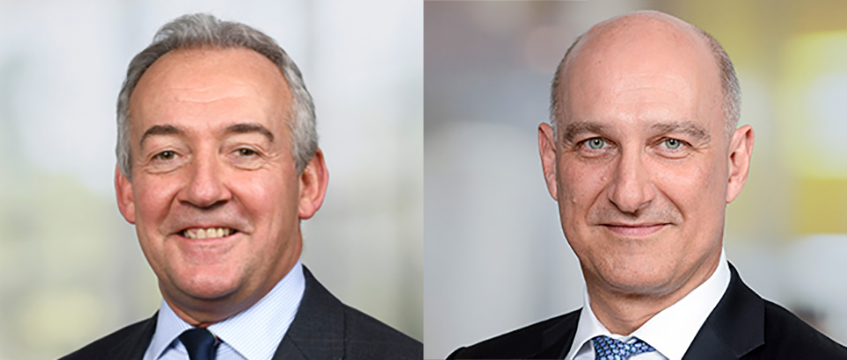Savills bosses call on ‘bench strength’ to weather market storms
Since Savills was founded in 1855, the agency has withstood “most war, pestilence, plague and a lot of down-market trends”, chief financial officer Simon Shaw tells EG. Its top team has worked through the past dozen years of ups and downs. However, Shaw says the playbook it operates with has stayed the same throughout.
That playbook involves a “conservative” financial structure that allows for the “flexibility to [retain] bench strength and invest during difficult markets, because that’s the best time in which to do so”, says Shaw (pictured above, right).
Savills’ bosses are relying on this approach to get them through a tough period for the transaction advisory business, which swung to a £17m loss in H1 2023, on a 20% fall in revenue to £328.7m. The decline was the main driver behind a 72% profit slump for the company during the period.
Since Savills was founded in 1855, the agency has withstood “most war, pestilence, plague and a lot of down-market trends”, chief financial officer Simon Shaw tells EG. Its top team has worked through the past dozen years of ups and downs. However, Shaw says the playbook it operates with has stayed the same throughout.
That playbook involves a “conservative” financial structure that allows for the “flexibility to [retain] bench strength and invest during difficult markets, because that’s the best time in which to do so”, says Shaw (pictured above, right).
Savills’ bosses are relying on this approach to get them through a tough period for the transaction advisory business, which swung to a £17m loss in H1 2023, on a 20% fall in revenue to £328.7m. The decline was the main driver behind a 72% profit slump for the company during the period.
The firm is the latest agency to report its H1 results. Savills highlighted that its “range of expectations for the year as a whole has reduced somewhat” on the back of prolonged uncertainty.
The tonic for market turmoil
Shaw says its strategy will allow for wiggle room when clients cannot pay Savills’ transaction fees during periods of low transactional volumes. “That is the prescription [for agencies to weather the storm],” he adds.
“We have seen it through the global financial crisis, we saw it through the Covid lockdowns, and I don’t think this is any different. At the moment, the world is simply taking its time to recalibrate at different paces, in different locations to the anticipated pattern of interest rates in the future.”
Chief executive Mark Ridley says Savills is making a “conscious strategic decision” to weight its business “towards recurring income as opposed to transactions”, to weather ongoing economic uncertainty.
“If we maintain core bench strength then we take market share for the future, and we have to take a long-term view,” says Ridley (pictured above, left).
“We continue with our strategy of investing in the areas that we have been growing,” adds Ridley, pointing to 16% year-on-year growth in property and facilities management revenue in H1.
“Property and facilities management revenue and profit are up, double digits for both, and that’s the biggest part of our businesses – it’s 43% of our global revenue.”
Recalibrating markets
More broadly, Ridley is upbeat that there is “significant dry powder still available to invest in global real estate”. He says: “Where, which markets and which sectors are going to invest may change, there’s no doubt about it.
“There is definitely negativity, in particular around secondary offices, understandably, just as there was in the past few years around retail. But retail has recalibrated, and the office markets are going to have to recalibrate through that process too.”
However, Ridley stresses that “it’s not all doom and gloom”, adding that London has been “one of the fastest” markets to recalibrate. Volumes in the capital are expected to improve more quickly than most.
“We are already seeing strong investor demand, which has led to London regaining its crown as the most popular cross-border destination,” Ridley says.
He observes that current conditions form part of the property cycle, and that the dip was “expected” given the recent market trajectory, but that the correction to follow will not be painless.
Shaw adds: “The investment world, not just in real estate, is getting used to the fact that the risk-free rate is meaningful today, whereas it hasn’t been really for the past decade, and that has an obvious consequential impact.”
To send feedback, e-mail chante.bohitige@eg.co.uk or tweet @bohitige or @EGPropertyNews
Image: Savills











